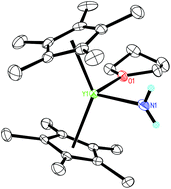NH3 and (NH2)1− as ligands in yttrium metallocene chemistry†
Abstract
(C5Me5)2Y(C3H5)(THF) reacts with ammonia in THF to form the first crystallographically-characterized rare-earth metal complex with a terminal (NH2)1− ligand, (C5Me5)2Y(NH2)(THF), 1. Complex 1 can be protonated with [HNEt3][BPh4] to form [(C5Me5)2Y(NH3)(THF)][BPh4], 2. Both complexes were characterized by X-ray crystallography which allowed a comparison of the Y–NH2 bond length, 2.226(2) Å, with an Y–NH3 bond length, 2.476(2) Å, in analogous coordination environments. Reactions of 2 with NaN3 and acetone produced the known complexes [(C5Me5)2YN3]x and [(C5Me5)2Y(OCMe2)2][BPh4], respectively, suggesting that the ammonia moiety in 2 functions as a displaceable solvate like THF.



 Please wait while we load your content...
Please wait while we load your content...
